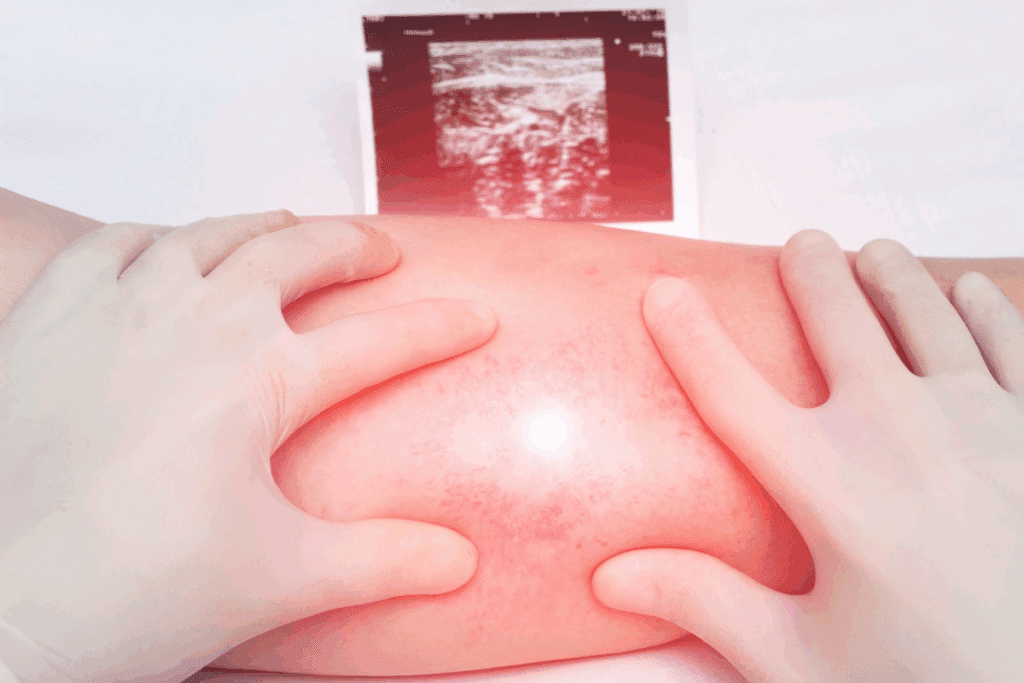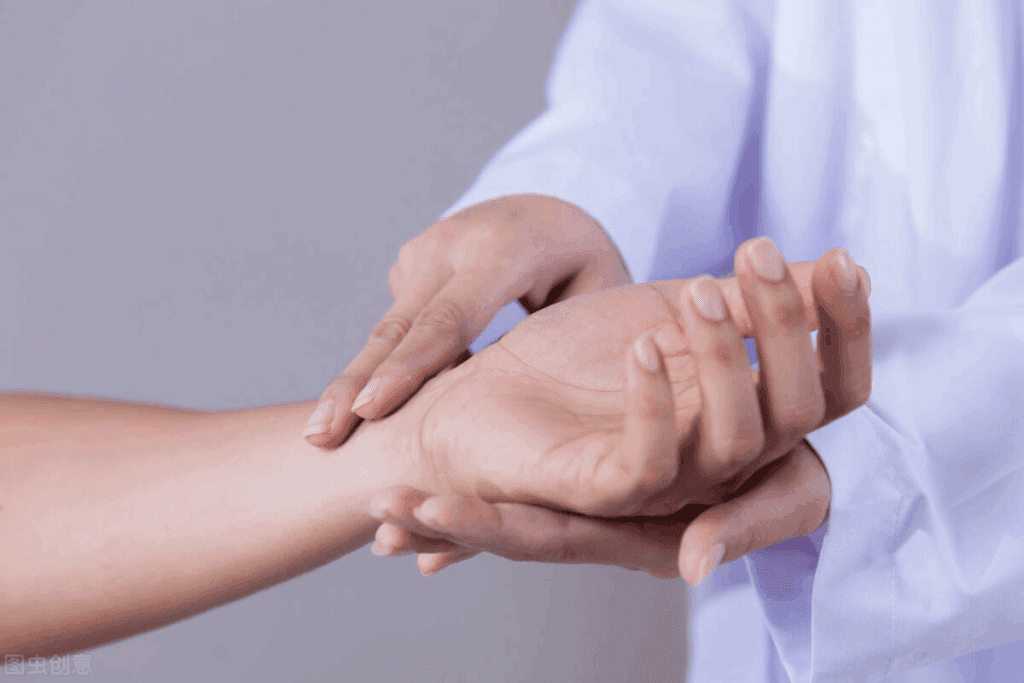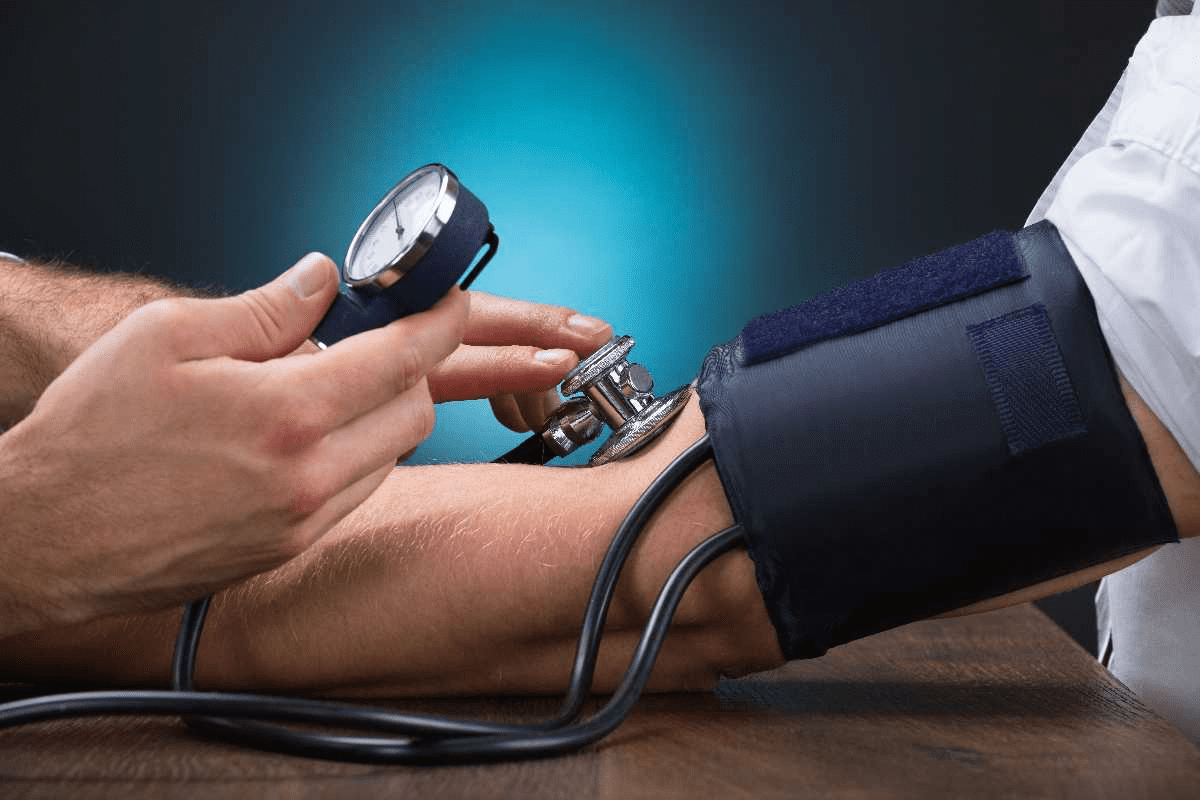Last Updated on November 26, 2025 by Bilal Hasdemir

Blood clots are a big health risk worldwide, affecting millions each year. At Liv Hospital, we know how critical it is to stop thrombosis and its dangers. Learn how to eliminate blood clots and prevent dangerous thrombosis. Our guide covers 7 proven methods, from medical treatments to lifestyle changes.
Preventing blood clots needs a full plan. This includes changing your lifestyle, eating better, and getting medical help. By choosing wisely, you can lower your risk of thrombosis a lot.
At Liv Hospital, we aim to give world-class healthcare. We focus on you, making sure you get care that keeps your blood flowing well.
Key Takeaways
- Learn about the dangers of thrombosis and how to avoid it.
- Start making lifestyle changes to lower blood clot risk.
- Adjust your diet to help your blood vessels stay healthy.
- Look into medical options for preventing thrombosis.
- Get care that’s tailored just for you from our experts.
Understanding Blood Clots and Their Dangers

Blood clots are a natural response to injury. But, they can be dangerous when they form in the wrong place. We’ll look at how they form and the risks they carry.
What Are Blood Clots and How Do They Form?
Blood clots are like gel-like clumps that form when blood cells and proteins stick together. They help stop bleeding when we’re hurt. But, they can also form in deep veins without injury, causing deep vein thrombosis (DVT).
The process of blood clot formation is complex:
- Platelets stick to the injury site.
- Clotting factors in the blood get activated, leading to fibrin formation.
- Fibrin traps blood cells, forming a clot.
When blood clots form in the wrong place, it can lead to serious health problems. For example, a clot can break loose and travel to the lungs, causing a pulmonary embolism. This is a serious and potentially deadly condition.
The Global Impact of Thrombosis
Thrombosis, or blood clots in blood vessels, is a big health issue worldwide. The World Health Organization (WHO) says it causes a lot of deaths every year.
The effects of thrombosis are wide-ranging:
- It’s a major cause of illness and death.
- It makes managing diseases like cancer and heart disease harder.
- It also costs a lot of money for healthcare.
It’s important to understand thrombosis to prevent and treat it. By knowing the signs of blood clots and their impact globally, we can lower the risk of thrombosis and its complications.
Recognizing the Warning Signs of Blood Clots

Knowing the signs of blood clots is key to avoiding serious issues. Blood clots can form in various parts of the body. Their symptoms differ based on where they occur.
Common Symptoms of Deep Vein Thrombosis
Deep Vein Thrombosis (DVT) happens when a blood clot forms in a deep vein, usually in the legs. You might notice:
- Swelling in the affected limb
- Pain or tenderness, mainly when standing or walking
- Warmth or redness in the affected area
The CDC says these signs could mean you have DVT. It’s important to see a doctor if these symptoms don’t go away or get worse.
Warning Signs of Pulmonary Embolism
A pulmonary embolism occurs when a blood clot reaches the lungs. This can be very dangerous. Look out for:
- Difficulty breathing or shortness of breath
- Chest pain that gets worse with deep breathing
- Coughing up blood
Healthdirect says these symptoms need quick medical help to avoid serious problems.
When to Seek Immediate Medical Attention
If you or someone you know has symptoms of DVT or pulmonary embolism, get medical help fast. Waiting too long can cause serious harm, even death.
Here’s a table to help you know when to get help right away:
| Symptom | Action |
| Swelling, pain, or warmth in one leg | Seek medical attention within 24 hours |
| Difficulty breathing or chest pain | Call emergency services immediately |
| Coughing up blood | Call emergency services immediately |
“Getting medical help quickly is vital for treating blood clots. Don’t wait if you notice any unusual symptoms.”
Knowing the warning signs and acting fast can greatly lower the risk of blood clot complications.
Risk Factors That Increase Your Chances of Developing Blood Clots
Many things can make you more likely to get blood clots. Knowing these risks is key to preventing them. This helps lower your chance of getting blood clots.
Genetic and Hereditary Factors
Genetics play a big part in blood clotting. If your family has a history of blood clots, you’re at higher risk. Some genetic changes, like Factor V Leiden, can make blood clot more easily.
Key Genetic Risk Factors:
- Family history of DVT or pulmonary embolism
- Genetic clotting disorders (e.g., Factor V Leiden, Antithrombin III deficiency)
Medical Conditions That Elevate Risk
Some health issues can raise your risk of blood clots. These include cancer, heart disease, and inflammatory disorders. For example, cancer can make your blood clot more, and heart problems can cause poor blood flow.
| Medical Condition | How It Increases Clot Risk |
| Cancer | Increases clotting factors, chemotherapy can damage blood vessels |
| Heart Disease | Poor circulation, atrial fibrillation can lead to clot formation |
| Inflammatory Disorders | Increases clotting factors, damages blood vessels |
Lifestyle Factors Contributing to Blood Clot Formation
What you do every day can also affect your clot risk. Being overweight, smoking, and sitting for long times can all increase your risk.
Lifestyle Modifications to Reduce Risk:
- Maintaining a healthy weight to reduce pressure on veins
- Quitting smoking to improve blood circulation
- Taking regular breaks to move when traveling or working long hours
By knowing and tackling these risk factors, you can lower your chance of getting blood clots. This helps avoid serious health problems.
How to Eliminate Blood Clots Through Physical Activity
Physical activity is key for keeping blood flowing well and preventing blood clots. Regular exercise boosts blood flow and strengthens muscles around blood vessels. This helps lower the chance of blood clots.
Recommended Exercises for Improving Circulation
Some exercises are better than others for improving blood flow and lowering blood clot risk. These include:
- Brisk Walking: Walking fast, at 3-4 miles per hour or more, greatly improves blood flow.
- Swimming: Swimming is a low-impact exercise that works many muscles without harming joints.
- Cycling: Stationary cycling or using a recumbent bike is a great way to boost blood flow.
- Leg Exercises: Simple leg exercises like ankle rotations, toe raises, and leg lifts can be done while seated or lying down.
Creating an Exercise Routine for Blood Clot Prevention
To make a good exercise plan for preventing blood clots, follow these tips:
- Start Slowly: Begin with short sessions (10-15 minutes) and gradually increase duration and intensity.
- Consistency is Key: Aim for at least 150 minutes of moderate-intensity exercise per week.
- Mix It Up: Include a variety of exercises to keep things interesting and prevent plateaus.
- Listen to Your Body: Rest when needed, and avoid overexertion.
Exercises to Avoid if You’re at High Risk
If you’re at high risk for blood clots, stay away from certain exercises. These can increase injury risk or clot formation. Avoid:
- High-Impact Activities: Stay away from activities with high-impact movements, like jumping or contact sports.
- Heavy Weightlifting: Lifting heavy weights can put too much pressure on veins and may dislodge a blood clot.
- Exercises That Cause Pain: Avoid any exercise that causes pain or discomfort, as it may indicate a problem.
By adding physical activity to your daily routine and choosing the right exercises, you can lower your risk of blood clots. This also improves your overall blood flow.
Dietary Changes That Help Prevent Blood Clots
Making some simple changes to your diet can help prevent blood clots. Adding certain foods and nutrients can keep your blood flowing well. This can also lower the chance of clots forming.
Foods That Naturally Thin the Blood
Some foods can thin your blood naturally. Eating fatty fish like salmon and mackerel is good. They have omega-3 fatty acids that are great for your heart and reduce inflammation.
Garlic also helps by stopping platelets from sticking together. And don’t forget leafy greens like spinach and kale. They’re full of vitamin K and antioxidants.
- Fatty fish rich in omega-3 fatty acids, such as salmon and mackerel
- Garlic, which contains compounds that help prevent platelet aggregation
- Leafy greens like spinach and kale, rich in vitamin K and antioxidants
Nutrients That Support Healthy Circulation
Some nutrients are key for keeping your blood flowing well. Vitamin C in citrus fruits and berries helps your blood vessels work better. Magnesium in dark chocolate and nuts relaxes your blood vessels.
Potassium in bananas and avocados keeps your blood pressure in check. These nutrients are important for your circulation.
- Vitamin C, found in citrus fruits and berries, which helps improve blood vessel function
- Magnesium, found in dark chocolate and nuts, which can help relax blood vessels
- Potassium, abundant in bananas and avocados, which helps regulate blood pressure
Foods to Limit or Avoid for Blood Clot Prevention
Some foods can increase your risk of blood clots. Foods high in saturated and trans fats, like processed meats and fried foods, are bad. They can make clots more likely.
Too much salt can also raise your blood pressure. This is a risk factor for clots. And don’t forget to limit sugary drinks and foods. They can cause inflammation and increase your clot risk.
- Foods high in saturated and trans fats, such as processed meats and fried foods
- Excessive salt intake which can lead to high blood pressure
- Sugary drinks and foods, which can contribute to inflammation and increase clot risk
Maintaining Proper Hydration to Reduce Blood Clot Risk
Keeping our bodies hydrated is key to avoiding blood clots and keeping our blood flowing well. Hydration means having enough fluids for our body to work right. Water is a big part of our blood, and not having enough can make our blood thicker and more likely to clot.
Dehydration happens for many reasons, like not drinking enough water, sweating too much, or having certain health issues. When we’re dehydrated, our body can’t move blood well or keep blood vessels healthy.
How Dehydration Affects Blood Viscosity
Dehydration makes our blood thicker by reducing the amount of plasma. This can increase the chance of blood clots. Without enough fluids, our body can’t move blood well, which can cause clots in deep veins or other places.
Even a little dehydration can make our heart work harder and reduce blood flow to important organs. It’s important to know the signs of dehydration, like dark urine, feeling dizzy, or having a dry mouth, and fix it fast.
Daily Hydration Guidelines for Optimal Blood Flow
How much water should we drink each day to stay hydrated and lower blood clot risk? The usual advice is to drink eight 8-ounce glasses of water a day, or the 8×8 rule. But, how much we need can change based on our age, sex, weight, and how active we are.
To make sure we drink enough water, follow these tips:
- Check your urine color: If it’s pale yellow or clear, you’re drinking enough.
- Drink water all day, not just at once.
- Drink more if you’re more active or in a hot place.
- Eat foods that help you stay hydrated, like watermelon or cucumbers.
By staying hydrated, we help our blood flow well and lower the risk of blood clots. It’s a simple but important step in fighting against blood clots.
Weight Management Strategies for Blood Clot Prevention
Being overweight increases the risk of blood clots. Keeping a healthy weight is key for overall health, and it helps prevent blood clots.
The Connection Between Obesity and Blood Clots
Studies link obesity to a higher risk of blood clots. This is due to inflammation, high blood pressure, and less movement. Extra fat can cause long-term inflammation, which helps clots form. Also, obesity often goes hand-in-hand with diabetes and high blood pressure, raising the risk even more.
Healthy Weight Loss Approaches for Reducing Risk
Managing weight involves diet, exercise, and sometimes medical help. Eating a diet full of fruits, veggies, whole grains, and lean proteins is key. Avoiding processed foods and foods high in sugar and fats is also important.
| Weight Loss Strategy | Description | Benefits |
| Dietary Changes | Eating a balanced diet with plenty of fruits, vegetables, and whole grains | Reduces inflammation, improves overall health |
| Increased Physical Activity | Engaging in regular exercise such as walking, cycling, or swimming | Improves circulation, burns calories, enhances cardiovascular health |
| Medical Interventions | Consulting with healthcare providers about weight loss medications or surgery | Can provide additional support for significant weight loss |
Using these strategies can lower blood clot risk and boost overall health. It’s wise to talk to a doctor for a weight loss plan that fits you.
Preventing Blood Clots During Long Periods of Immobility
Long periods without moving can lead to blood clots. It’s important to take steps to prevent this. Whether you’re traveling, in the hospital, or at a desk job, there are ways to lower your risk.
Strategies for Long-Distance Travel
When you travel far, it’s key to stay active. Try simple moves like ankle rotations, toe raises, and stretching your legs to boost blood flow. The CDC says to get up and move every 2-3 hours on long trips. Wearing compression stockings can also help keep blood flowing.
- Drink lots of water to stay hydrated.
- Avoid crossing your legs or ankles to keep blood flowing.
- Choose seats with more legroom if you can.
Healthdirect notes that moving often on trips can cut down on blood clot risk. Many health groups agree with this advice.
Preventing Clots During Hospital Stays and Recovery
Hospital patients face a higher risk of blood clots. Doctors often suggest using anticoagulant meds, compression stockings, and compression devices. It’s important to follow their advice and stay active as much as you can.
“Early mobilization after surgery is a key factor in reducing the risk of venous thromboembolism,” according to clinical guidelines.
At home, keep up with the preventive steps your doctor recommended. This might include wearing compression stockings or doing gentle exercises as suggested.
Desk Job Considerations and Preventive Measures
If you have a desk job, moving more is essential. Make sure to stand, stretch, and walk around regularly. Think about using a sit-stand desk or a stability ball instead of sitting all day.
- Plan breaks to stand, stretch, and walk.
- Do simple desk exercises like chair squats or leg raises.
- Try a walking meeting or a lunchtime walk.
By using these tips, you can lower your risk of blood clots when you’re not moving much.
Medical Interventions and Treatments for Blood Clot Prevention
Preventing blood clots often requires lifestyle changes and medical treatments. These are chosen based on the person’s risk factors. For many, medical treatments are key to their prevention plan.
Understanding Anticoagulant Medications
Anticoagulant medications are key in preventing blood clots. They stop the body’s clotting process, lowering clot risk. Common anticoagulants include warfarin, heparin, and aspirin, each with its own use and monitoring needs.
Warfarin needs regular blood tests to check its effect and adjust doses. Heparin is often used in hospitals for quick clot prevention. Aspirin is sometimes used for those at lower risk because of its effect on platelets.
Novel Oral Anticoagulants (NOACs) and Their Benefits
Novel Oral Anticoagulants (NOACs) are a newer type of medication. They are popular because of their predictable effects and less need for monitoring. NOACs, like dabigatran, rivaroxaban, and apixaban, have benefits over traditional anticoagulants like warfarin.
- They have a more predictable effect, eliminating the need for regular blood monitoring.
- They have fewer dietary restrictions, making them more convenient for patients.
- They are less likely to interact with other medications.
Monitoring and Managing Blood Thinner Therapy
Managing blood thinner therapy is key to avoid both clotting and bleeding. Regular follow-up with healthcare providers is essential to check the therapy’s safety and effectiveness.
Patients on blood thinners should watch for signs of bleeding or clotting. They should also know when to seek medical help. It’s important to tell their healthcare providers about any changes in their health or medication.
“The key to successful anticoagulation therapy lies in a collaborative approach between the patient and healthcare provider, ensuring that the treatment is both effective and safe.”
— Medical Expert in Cardiology
Interventional Procedures Like IVC Filters
For those who can’t take blood thinners or have clots despite treatment, interventional procedures like IVC filter placement might be considered.
IVC filters catch blood clots before they reach the lungs, preventing pulmonary embolism. But, they are used only in specific cases due to possible complications and other effective treatments.
In conclusion, medical interventions are vital in preventing blood clots. They offer various options based on individual needs. By understanding these treatments and working with healthcare providers, patients can greatly lower their risk of thrombosis.
Using Compression Stockings and Mechanical Devices
Compression stockings and mechanical devices are simple yet effective ways to improve blood flow and prevent clots. They are great for people at high risk of blood clots. This includes those who are about to have surgery, pregnant women, and those with a history of deep vein thrombosis (DVT).
Types of Compression Stockings and Their Benefits
Compression stockings come in different levels and lengths. The most common types include:
- Knee-High Stockings: These are good for those needing compression below the knee.
- Thigh-High Stockings: These offer compression up to the thigh, great for more circulation issues.
- Full-Length Stockings: Also known as pantyhose, these provide compression from the feet to the waist.
Compression stockings improve blood flow, reduce swelling, and lower the risk of blood clots. Health guidelines show they can greatly reduce DVT risk in hospitalized patients and during long trips.
Proper Fitting and Usage Guidelines
To get the most from compression stockings, fitting is key. Here are some tips:
- Measure your legs at the widest part of the calf and ankle to find the right size.
- Put on compression stockings in the morning when your legs are less swollen.
- Make sure the stockings are not twisted and are evenly distributed.
- Remove the stockings at night unless a healthcare professional tells you not to.
Following the manufacturer’s care and maintenance instructions is also important. This keeps the stockings effective.
Other Mechanical Prevention Methods
Other than compression stockings, there are mechanical devices to prevent blood clots. These include:
- Intermittent Pneumatic Compression (IPC) Devices: These inflate and deflate sleeves around the legs to boost circulation.
- Foot Impulse Devices: These devices stimulate the plantar venous plexus to improve blood flow.
These mechanical methods can be used alone or with anticoagulant medications for better protection against blood clots.
Special Considerations for High-Risk Populations
It’s important to know the challenges faced by high-risk groups for blood clot prevention. Some people are more likely to get blood clots because of their health or body state.
Pregnancy and Postpartum Blood Clot Prevention
Pregnancy raises the risk of blood clots because of more blood and vein pressure. Pregnant women should drink lots of water, keep a healthy weight, and follow their doctor’s advice on exercise.
After giving birth, women should watch for blood clot signs like leg swelling, pain, or redness. If they see these, they should get medical help right away.
“Pregnancy is a hypercoagulable state, making pregnant women more prone to blood clots. Awareness and preventive measures are critical.”
Medical Expert in Obstetrics
Strategies for Older Adults
Older adults face a higher risk of blood clots because of less movement, health issues, and blood vessel changes with age. Regular exercise, like walking or stretching, can help blood flow.
- Drink plenty of water to stay hydrated
- Avoid sitting or lying down for too long
- Wear compression stockings if a doctor suggests it
| Strategy | Benefit |
| Regular Exercise | Improves circulation and reduces blood clot risk |
| Proper Hydration | Helps maintain blood flow and prevents dehydration |
| Compression Stockings | Reduces swelling and improves blood flow in the legs |
Prevention After Surgery or Hospitalization
People who have had surgery or been in the hospital are at higher risk for blood clots. Taking anticoagulant medicine as advised and moving around early can help a lot.
It’s also key to know the signs of blood clots and tell a doctor if you notice them.
By knowing the risks and taking steps to prevent them, high-risk groups can lower their chance of getting blood clots.
Conclusion: Creating Your Personalized Blood Clot Prevention Plan
Understanding your risk factors is key to preventing blood clots. By making lifestyle changes and using medical treatments when needed, you can lower your risk. We’ve shared important steps to avoid blood clots, like staying active, eating right, drinking enough water, and managing your weight.
To make a plan that’s right for you, think about your risk factors, health, and lifestyle. It’s smart to talk to your doctor about what’s best for you. They might suggest medicines, compression stockings, or other devices to help.
Creating a good prevention plan is about more than just one thing. It’s about combining healthy habits with medical advice. This way, we can all keep our blood vessels healthy and lower the chance of blood clots. Start making your plan today by looking at your risk and taking steps towards a healthier future.
FAQ
.
What are the main risk factors for developing blood clots?
Risk factors include genetic predispositions and certain medical conditions like cancer and heart disease. Lifestyle choices like smoking and immobility also play a role.
How can I prevent blood clots through diet?
Eat foods that thin the blood, like omega-3 rich foods. Include leafy greens for vitamin K. Avoid foods high in saturated fats and salt.
What role does hydration play in preventing blood clots?
Hydration is key. Dehydration makes blood more likely to clot. Drinking water helps keep blood flowing well.
Can exercise help prevent blood clots?
Yes, exercise improves circulation and prevents clots. Walking, cycling, and swimming are good. Avoid high-impact exercises if you’re at risk.
How can I prevent blood clots during long-distance travel?
Stay hydrated and move regularly. Wear compression stockings to help prevent clots during travel.
What are the symptoms of deep vein thrombosis (DVT) and pulmonary embolism?
DVT symptoms include leg swelling, pain, and tenderness. Pulmonary embolism symptoms are sudden breathlessness, chest pain, and coughing up blood. Seek medical help if you notice these signs.
Are there any medical interventions for blood clot prevention?
Yes, treatments include anticoagulant medications and IVC filters for high-risk individuals.
How do compression stockings help prevent blood clots?
They apply pressure to improve circulation. This prevents blood from pooling and clotting. Make sure they fit well for best results.
What are the special considerations for preventing blood clots in pregnant women?
Pregnant women are at higher risk due to increased blood volume and increased venous pressure. Stay hydrated, move regularly, and consider anticoagulant therapy under a doctor’s guidance.
How can older adults reduce their risk of blood clots?
Stay active, maintain a healthy weight, and stay hydrated. Manage chronic conditions and discuss risks with your doctor.
What is the connection between obesity and blood clot risk?
Obesity increases blood clot risk due to decreased mobility and increased venous pressure. Losing weight can help reduce this risk.
When should I seek immediate medical attention for a suspected blood clot?
Seek immediate help for symptoms like sudden leg swelling, pain, shortness of breath, or chest pain
References
- Mangiafico, M., Oberti, F., Giubilato, S., Luzzati, R., Squadrito, F., Bono, A., … & Di Stasi, S. (2024). Superficial venous thrombosis: A comprehensive review. Healthcare, 12(4), 500. https://www.mdpi.com/2227-9032/12/4/500
- StatPearls [Internet]. (2023). Superficial thrombophlebitis. Treasure Island (FL): StatPearls Publishing. https://www.ncbi.nlm.nih.gov/books/NBK556017/
- Zhang, Y., Ding, J., Guo, H., Liang, J., & Li, Y. (2020). Associations of Fish and Omega-3 Fatty Acids Consumption With the Risk of Venous Thromboembolism: A Meta-Analysis of Prospective Cohort Studies. Frontiers in Nutrition, 7, 614784. https://www.frontiersin.org/journals/nutrition/articles/10.3389/fnut.2020.614784/full






